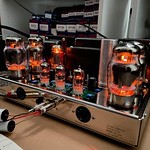a) The ST120 is truly an elegant piece of tube-gear.
b) The assembly was flawless, the parts quality, spacing, and general layout clean and easy to understand.
c) The AB board was also an elegant piece of kit, using a good quality board, nicely masked and with through-plated soldering pads.
So, based on first-impressions, I looked forward to a relatively simple install. No such luck.
I keep a very nice bench AC power-supply, so pre-biasing the board was direct and simple.
Pavel advises that the VTA board be removed for installation. Simply not practical when the Volume Control is installed. It would require undoing much of Bob's handiwork and greatly multiply occasions for error.
The two tall caps on the VTA board must be replaced with short caps for clearance. Given that those caps terminate under the chassis, getting to them required my flexible soldering iron (not really), which I managed with great caution, super good light and care.
It took two (2) passes with Pavel to get the correct installation instructions. Had I followed what I was given both by the amp owner and from Pavel the first time... well...
HOWEVER, once the correct instructions arrived, it was an easy finish.
At which point, the board performed as-planned and as-advertised.
Now, the quibbles:
Directions. I believe that path is now cleared up, and new boards will have new directions, which will be easily followed and give good results.
Hardware supplied: Missing screws. Two stand-offs per leg, should be one.
Board does not clear the Volume control, and so that corner, and the one one the other side cannot be tightened down. I used the original KEP nut, my own 4-40 stainless steel screws (not going to pollute with mild steel) and tiny wrenches to secure the two corners against 'wiggle'.
Owner wanted me to drill the VTA board to expose the LEDs for visual verification. The PIO caps prevented that option. Pavel was good enough to supply that board without the SMT LEDs, but to no avail. I mounted conventional Blue LEDs on the back - they light, but are invisible. Perhaps a fiber-optic cable might be an option.
The soldering techniques required by the install, to me, verge on the dangerous - I have very nearly 50 years experience with soldering, so, I used that experience to make the best of difficult choices. Funny thing, if Bob Latino were a sloppier technician, it would have been easier. BUT!! I repeat, those who do not have absolute confidence in their technique should get help on this part of the install.
Conclusions:
Whereas the board is functional and meets the need and the goal, it should be physically modified to accommodate the volume control. Were an ALPS type control installed - there would have been no way to install it.
Pavel and Bob should work out something so that some of the key soldering points on the VTA board were accommodated, rather than double-connecting and relying solely on the strength of the solder to maintain the connection. I use good, fresh 63/37 Eutectic Solder from a top source, but it still leaves me feeling squirrelly.
Nor would I install such a device on my personal equipment. I like the (or tell myself I like) the hands-on maintenance aspect of biasing. That is a personal prejudice, not a criticism.
This was an excellent learning experience, and well worth the price of admission - had all things been aligned from the beginning, start-to-finish, it would have been a 3-hour ordeal as I am a measure-twice/cut-once type, measure-3x on some one else's gear.



